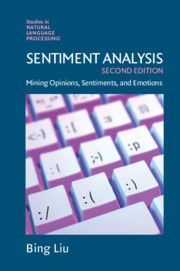Book contents
- Sentiment Analysis
- Studies in Natural Language Processing
- Sentiment Analysis
- Copyright page
- Contents
- Preface
- Acknowledgments
- 1 Introduction
- 2 The Problem of Sentiment Analysis
- 3 Document Sentiment Classification
- 4 Sentence Subjectivity and Sentiment Classification
- 5 Aspect Sentiment Classification
- 6 Aspect and Entity Extraction
- 7 Sentiment Lexicon Generation
- 8 Analysis of Comparative Opinions
- 9 Opinion Summarization and Search
- 10 Analysis of Debates and Comments
- 11 Mining Intent
- 12 Detecting Fake or Deceptive Opinions
- 13 Quality of Reviews
- 14 Conclusion
- Appendix
- Bibliography
- Index
8 - Analysis of Comparative Opinions
Published online by Cambridge University Press: 23 September 2020
- Sentiment Analysis
- Studies in Natural Language Processing
- Sentiment Analysis
- Copyright page
- Contents
- Preface
- Acknowledgments
- 1 Introduction
- 2 The Problem of Sentiment Analysis
- 3 Document Sentiment Classification
- 4 Sentence Subjectivity and Sentiment Classification
- 5 Aspect Sentiment Classification
- 6 Aspect and Entity Extraction
- 7 Sentiment Lexicon Generation
- 8 Analysis of Comparative Opinions
- 9 Opinion Summarization and Search
- 10 Analysis of Debates and Comments
- 11 Mining Intent
- 12 Detecting Fake or Deceptive Opinions
- 13 Quality of Reviews
- 14 Conclusion
- Appendix
- Bibliography
- Index
Summary
Apart from directly expressing positive or negative opinions about an entity and/or its aspects, one can also express opinions by comparing similar entities. Such opinions are called comparative opinions (Jindal and Liu, 2006a, 2006b). Comparative opinions have different semantic meanings from regular opinions as well as different syntactic forms. For example, a typical regular opinion sentence is “The voice quality of this phone is amazing,” and a typical comparative opinion sentence is “The voice quality of Moto X is better than that of iPhone 5.” This comparative sentence does not say that any phone’s voice quality is good or bad, but simply states a relative ordering in terms of voice quality of the two smartphones. Like regular sentences, comparative sentences can be opinionated or not-opinionated. The preceding comparative sentence is clearly opinionated because it explicitly expresses a comparative sentiment, while the sentence “Samsung Galaxy 4 is larger than iPhone 5” expresses no sentiment, at least not explicitly.
- Type
- Chapter
- Information
- Sentiment AnalysisMining Opinions, Sentiments, and Emotions, pp. 243 - 258Publisher: Cambridge University PressPrint publication year: 2020

